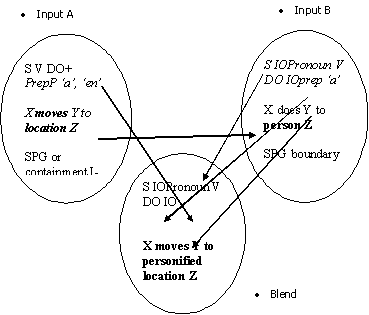Rosana pone betún a los zapatos
Rosanna puts polishing cream to the shoes (she polishes the shoes)
Rosana pone un cuadro en la pared
Rosanna puts a picture on the wall
Rosana pone azúcar en el café
Rosanna puts sugar in the coffee
 |
| ISSN: 1139-8736 |
3. Destination Construction
Spanish shares with many other languages a destination construction based on the basic form-meaning pair “X moves Y in relation to destination Z.” In it an X-schema of movement is used to express the transitive relation between Agent and Patient (see also Langacker 1987; Langacker 1999), and different I-schemas are used to express the relation between the mover and “movee” in respect to the background of the movement:
Rosana pone betún a los zapatos
Rosanna puts polishing cream to the shoes (she polishes the shoes)
Rosana pone un cuadro en la pared
Rosanna puts a picture on the wall
Rosana pone azúcar en el café
Rosanna puts sugar in the coffee
 |
But Spanish, unlike other Romance languages or English, has created another form-meaning pair to express destination, in which the destination becomes personalized and a participant in the event.
Spanish blends the structure and meaning of the aforementioned constructions with the structure and meaning of the Indirect Object construction. This is done in order to come up with this new construction, very pervasive and productive in Spanish:
Let’s examine the blend involved in example number 2:
 |
Input 1: Destination Construction X moves Y to destination Z
Input 2: Indirect Object Construction X does Y to recipient Z
Blend: Blended Destination Construction X moves Y to personified location Z
As we said before, this construction is very productive in Spanish:
Notes
2 Most of the examples are taken from a verb-list produced by the Base de datos sintáctica created by the University of Santiago de Compostela. www.bds.usc.es/ Other examples are taken from native-speaker informants.Volumen 23 (2006) ISSN: 1139-8736 |